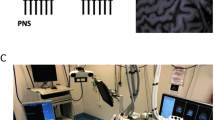Abstract
Following stroke, an abnormally high interhemispheric inhibitory drive from the contralesional to the ipsilesional primary motor cortex (M1) is evident during voluntary movement. Down-regulating motor excitability of the contralesional M1 using inhibitory neuromodulatory protocols has demonstrated a correlation between balanced interhemispheric interactions and increased motor recovery. In 2005, our laboratory first reported bidirectional modulation of healthy subjects’ tibialis anterior (TA) motor excitability during walking, using a stimulation paradigm known as paired associative stimulation (PAS). Suprathreshold transcranial magnetic stimulation (TMS) of the lower limb M1 paired with electrical stimulation of the common peroneal nerve produced a persistent modulation of TA corticomotor excitability. The present study tested the hypothesis that the excitability of the ipsilesional lower limb motor cortex during walking is increased when inhibitory PAS is applied to the contralesional motor cortex in chronic stroke survivors. We applied inhibitory PAS (120 pairs at 0.5 Hz) to the quiescent paretic TA of ten chronic stroke patients and the right TA of ten age-matched healthy subjects. Post intervention excitability measures were taken immediately following PAS, and again 5, 10 and 15 min later. When inhibitory PAS was applied to the non-paretic TA of chronic stroke subjects, the non-paretic TA motor evoked potential (MEP) amplitude decreased to 91% and paretic TA MEP amplitude increased to 130% (of pre-PAS values) during post-PAS walking. In healthy subjects, MEPs in response to TMS revealed that mean MEP amplitude from the stimulated TA decreased to 87% and the mean MEP amplitude from the non-stimulated TA increased to 126%. This is the first study to demonstrate that inhibitory PAS applied to the contralesional lower limb motor system of stroke survivors increases motor excitability of the paretic lower limb assessed during walking. This finding suggests that inhibitory PAS may be a useful tool to study how the human lower limb motor cortex recovers after neural injury, and that PAS may be a candidate adjuvant therapy for patients with neurological walking impairments.


Similar content being viewed by others
References
Chen R, Cohen LG, Hallett M (2002) Nervous system reorganization following injury. Neuroscience 111:761–773
Ferbert A, Priori A, Rothwell JC, Day BL, Colebatch JG, Marsden CD (1992) Interhemispheric inhibition of the human motor cortex. J Physiol 453:525–546
Fregni F, Boggio PS, Mansur CG, Wagner T, Ferreira MJ, Lima MC, Rigonatti SP, Marcolin MA, Freedman SD, Nitsche MA, Pascual-Leone A (2005) Transcranial direct current stimulation of the unaffected hemisphere in stroke patients. Neuroreport 16:1551–1556
Hebb DO (1949) The organization of behavior. Wiley, New York
Jayaram G, Santos L, Stinear JW (2007) Spike-timing-dependent plasticity induced in resting lower limb cortex persists during subsequent walking. Brain Res 1153:92–97
Kobayashi H, Hutchinson S, Theoret H, Schlaug G, Pascual-Leone A (2004) Repetitive TMS of the motor cortex improves ipsilateral sequential simple finger movements. Neurology 62:91–98
Liepert J, Bauder H, Miltner W H R, Taub E, Weiller C (2000) Treatment-induced cortical reorganization after stroke in humans. Stroke 31:1210–1216
Mansur CG, Fregni F, Boggio PS , Riberto M, Gallucci-Neto J, Santos CM, Wagner T, Rigonatti SP, Marcolin MA, Pascual-Leone A (2005) A sham-stimulated-controlled trial of rTMS of the unaffected hemisphere in stroke patients. Neurology 64:1802–1804
Miltner W, Bauder H, Sommer M, Dettmers C, Taub E (1999) Effects of constraint-induced movement therapy on patients with chronic motor deficits after stroke. Stroke 30:586–592
Murase N, Duque J, Mazzocchio R, Cohen LG (2004) Influence of interhemispheric interactions on motor function in chronic stroke. Ann Neurol 55:400–409
Petersen N, Christensen LO, Nielsen J (1998) The effect of transcranial magnetic stimulation on the soleus H reflex during human walking. J Physiol 513:599–610
Petersen NT, Butler JE, Marchand-Pauvert V, Fisher RJ, Ledebt A, Pyndt HS, Hansen NL, Nielsen JB (2001) Suppression of EMG activity by transcranial magnetic stimulation in human subjects during walking. J Physiol 537(2):651–656
Prior M, Stinear JW (2006) Phasic spike-timing dependent plasticity of human cortex. Brain Res 1110:150–158
Roy FD, Norton JA, Gorassini MA (2007) Role of sustained excitability of the leg motor cortex after transcranial magnetic stimulation in associative plasticity. J Neurophysiol 98:657–667
Stefan K, Kunesch E, Cohen LG, Benecke R, Classen J (2000) Induction of plasticity in the human motor cortex by paired associative stimuli. Brain 123:572–584
Stinear JW, Hornby TG (2005) Stimulation-induced changes in lower limb corticomotor excitability during treadmill walking. J Physiol 567.2:701–711
Takeuchi N, Chuma T, Matsuo Y, Watanabe I, Ikoma K (2005) Repetitive transcranial magnetic stimulation of contralesional primary motor cortex improves hand function after stroke. Stroke 36:2681–2686
Traversa R, Cicinelli P, Bassi A, Rossini P, Bernardi G (1997) Mapping of motor cortical reorganization after stroke. A brain stimulation study with focal magnetic pulses. Stroke 28:110–117
Uy J, Ridding MC, Hillier S, Thompson PD, Miles TS (2003) Does induction of plastic change in motor cortex improve leg function after stroke? Neurology 61:982–984
Acknowledgments
The study was funded by grants from the American Heart Association, the National Institute on Disability and Rehabilitation Research, and the Ralph and Marion C. Falk Medical Research Trust, to W. Z. Rymer MD, PhD, Principal Investigator. Special thanks to Michelle Prior MS for patient recruitment.
Author information
Authors and Affiliations
Corresponding author
Rights and permissions
About this article
Cite this article
Jayaram, G., Stinear, J.W. Contralesional paired associative stimulation increases paretic lower limb motor excitability post-stroke. Exp Brain Res 185, 563–570 (2008). https://doi.org/10.1007/s00221-007-1183-x
Received:
Accepted:
Published:
Issue Date:
DOI: https://doi.org/10.1007/s00221-007-1183-x




